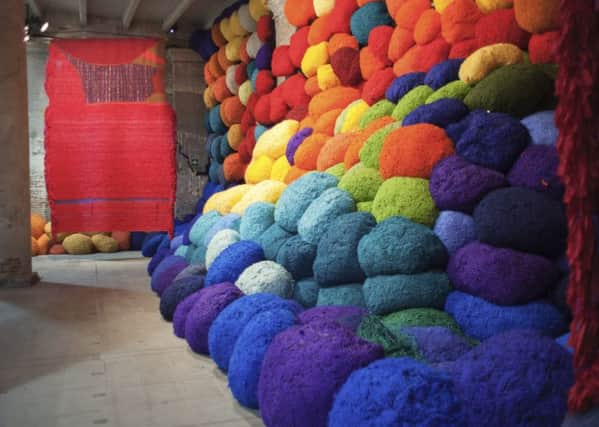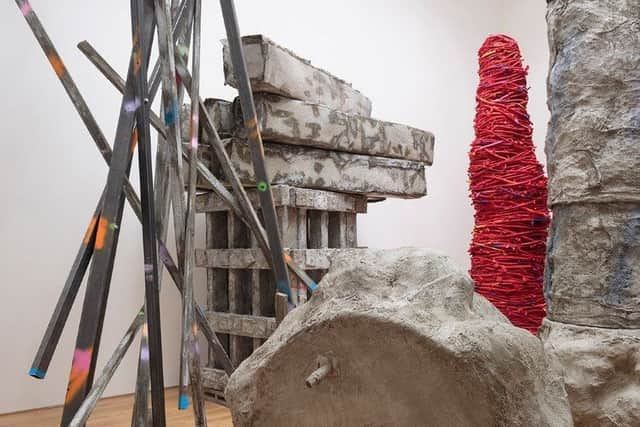Art: Moira Jeffrey reports from the Venice Biennale


At the entrance to the Cordiere, the massive former ropeworks that is part of Venice’s Arsenale – the medieval naval dockyard that was once the largest industrial complex in the world – the artist Lee Mingwei has been sitting mending torn clothes.
The Mending Project consists of a spectacular wall of reels of coloured threads and a more prosaic work table. If you ask the artist, or the volunteers who will go on to staff the project until the 57th Venice Biennale’s close in November, they will both stitch your clothes and chat to you during the process. Mending not only consists of fixing what is damaged but is a kind of human restoration: a healing and binding.
Advertisement
Hide AdAdvertisement
Hide AdYou come to Venice to sense the winds changing. The last Venice Biennale, in 2015, was characterised by a furious urgency as the full extent of the refugee crisis in the Mediterranean was emerging. Its signature work was the beautiful, devastating film installation Vertigo Sea by the British artist John Akomfrah, a retelling of Moby Dick for an age of ecological and humanitarian crime.


This year, the main exhibitions in the Arsenale and the central pavilion in the Giardini, curated by Christine Macel, formerly of the Pompidou, suggest another tone altogether. In the face of immense challenges she seems to have turned inward. Her vision of the artist is as a healer, shaman, and as diligent maker. In the Arsenale that translates as an at times too literal use of artists who use textiles, threads and suspended materials but in its strongest moments – such as an excellent work of suspended paper lightly dusted in chalk by Scotland’s Karla Black or a vast wall of textiles by the American artist Sheila Hicks – she just about pulls it off.
It is elsewhere that one finds a sense of urgency or current conversation. In the Irish Pavilion show, which has been commissioned and curated by Tessa Giblin, the director of Edinburgh’s Talbot Rice Gallery, and which will be exhibited in the gallery next year, the artist Jesse Jones has pulled off a triumph. Tremble, Tremble is a Pandora’s box of a film installation which unleashes a stagey, supernatural yet utterly compelling witch on the audience. Within an elaborate setting of gauzy curtains you are enveloped in a giant maternal embrace, in a space strewn with spotlit sculptures of bones.
Conceived with the extraordinary Irish/Breton actor Olwen Fouéré the film shows a witch placing a curse on the Irish Judiciary for centuries of oppressing women. Jones’s work quotes everything from medieval court cases to the Italian feminist campaigns in the 1970s for wages for housework. But amidst a growing wave of anger from secular Ireland, it is perfectly contemporary. It opened the week that it was announced that Stephen Fry was no longer going to be prosecuted under controversial Irish blasphemy laws.
Blasphemy is everywhere in Venice, a city devoted equally to god and mammon. Scotland’s presentation with Rachel Maclean (reviewed last week) makes the most of its setting in a deconsecrated church. Scotland held an opening event in the cloisters of the church’s former nunnery. After a DJ set by Glasgow musician and sound engineer Julian Corrie, who worked on Maclean’s film, the evening closed with a chaotic but energising Strip the Willow.


In the Giardini, the city park that hosts many of the main national pavilions, the highlights are few this year. Phyllida Barlow, the 73 year-old sculptor, has pulled off her show in the chilly classical spaces of the British Pavilion with an exhibition entitled folly. It is packed with her signature high stacks of timber and unruly constructions of concrete, wire and scrim. On approach the pavilion is bursting at the seams with giant, awkward baubles. Inside, a makeshift anvil sits atop a stack of wood from old pianos, tall cement pillars are slashed and lop-sided, and a balcony protrudes awkwardly from a wall.
Nearby in the German pavilion Anne Imhof’s Faust is a chilly, compelling transformation of the pavilion and a series of long staged performances that are the highlight of the Giardini. The outside of the building is fenced off, its perimeters patrolled by a family of Doberman Pinschers. Black clad figures come and go, vaguely martial, climbing the fences until they reach the top of the building itself. A girl crouches amongst the canines, becoming animal.
Advertisement
Hide AdAdvertisement
Hide AdThe conventional doors in the building have been glassed off, and you walk on glass mezzanine. Beneath you figures move in ritualistic performances of music and washing. Scattered around the floor are ominous bits of electrical equipment, instruments, vast steel sinks and soap. You may be in a makeshift hospital or even a morgue. Pleasure and pain, beautiful music and a deep sense of estrangement abound. You feel like you are watching a remote anarchist cell train for some unspecified revolt.
In the Tunisian Pavilion, the friendly men behind the glass wall there are the most relaxed immigration officers I have ever encountered. Present your thumb print and a signature at the immigration desk and you will get a document they are calling a “freesa”, and the injunction that you can go wherever you want to go. It’s a gentle moment that makes a brutal point.
Much of Macel’s show is about the recuperation of older artists, many of them women, but she plays this card so many times it seems to diminish the effect. Elsewhere in the Biennale, older artists and bodies of work do stand well when given space and time to breathe. This is the case for the wonderful Romanian Pavilion, devoted to the 91 year-old artist Geta Brătescu, whose work in drawing, prints and performance staked a claim for the freedom of the studio in the most straitened of circumstances.
Another exhibition of museum retrospective quality is Doing Time devoted to the Taiwanese New Yorker Tehching Hsieh, who made a series of extraordinary year-long performances in the city in the early 1980s. For Outdoor Piece, he lived and slept on the streets for a year. The documentation is a visceral description of exclusion and the struggle to survive and it speaks urgently to current conditions, both of statelessness and homelessness. It leaves you not mended or healed but unbearably sad.
The Venice Biennale 2017 runs until 26 November.